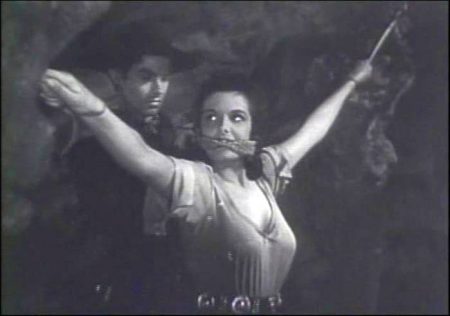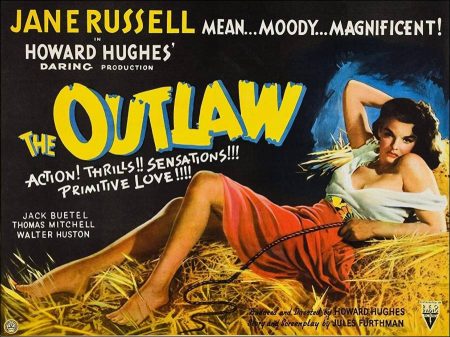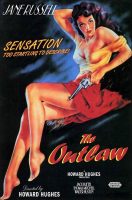The Outlaw movie storyline. In the 19th Century, in the town of Lincoln, New Mexico, the sheriff Pat Garrett welcomes his old friend, Doc Holliday, who has had his horse Red stolen by a stranger while coming to the town. They meet the thieve and realize that the guy is the gunman Billy the Kid. Doc becomes friend of Billy, but Pat invites them to leave Lincoln in the afternoon.
There is an incident, Pat wounds Billy the Kid, and Doc asks his girlfriend Rio McDonald to take care of Billy while he would misguide Pat Garret t and his officers. There is a romance between Billy the Kid and Rio, and when the hit-man is healed, he disputes with Doc the possession of Red and Rio, with Pat Garrett chasing them. On 13 July 1881, this hunting ends in a tragic way.
The Outlaw is a 1943 American Western film, directed by Howard Hughes and starring Jack Buetel, Jane Russell, Thomas Mitchell, and Walter Huston. Hughes also produced the film, while Howard Hawks served as an uncredited co-director. The film is notable as Russell’s breakthrough role, turning the young actress into a sex symbol and a Hollywood icon. Later advertising billed Russell as the sole star.

In 1941, while filming The Outlaw, Hughes felt that the camera did not do justice to Jane Russell’s bust. He employed his engineering skills to design a new cantilevered underwire bra to emphasize her figure. Hughes added curved structural steel rods that were sewn into the brassiere under each breast cup and connected to the bra’s shoulder straps. This arrangement allowed the breasts to be pulled upwards and made it possible to move the shoulder straps away from the neck. As a result, the design allowed for a larger amount of Russell’s bosom to be exposed. Contrary to many media reports afterward, Russell did not wear the bra during filming; according to her 1988 autobiography, she said the bra was so uncomfortable that she secretly discarded it. She wrote that the “ridiculous” contraption hurt so much that she wore it for only a few minutes, and instead wore her own bra. To prevent Hughes from noticing, Russell padded the cups with tissue and tightened the shoulder straps before returning to the set. She later said “I never wore it in The Outlaw, and he never knew. He wasn’t going to take my clothes off to check if I had it on. I just told him I did.”[6] The famed bra ended up in a Hollywood museum—a false witness to the push-up myth. Although the film was completed in February 1941, Hughes had trouble getting it approved by the Hollywood Production Code Administration due to its emphasis on and display of Russell’s breasts. The Production Administration set the standards for morally acceptable content in motion pictures, and ordered cuts to the film. Hughes reluctantly removed about 40 feet, or a half-minute, of footage that prominently featured Russell’s bosom. However, 20th Century Fox decided to cancel its agreement to release The Outlaw; as a result, Hughes stood to lose millions of dollars. Ever the resourceful businessman, he schemed to create a public outcry for his film to be banned. Hughes had all his managers call ministers, women’s clubs and housewives, informing them about the ‘lewd picture’ Hughes was about to release. The public responded by protesting and trying to have the film banned, which generated the publicity Hughes needed to establish a demand for the film and get it released. The resulting controversy created enough interest to get The Outlaw into theaters for just one week in 1943, and then it was pulled due to violations of the Production Code. The film was released widely on April 23, 1946 when RKO Radio Pictures premiered the film in San Francisco, where it became a box-office hit. By the end of 1946, the film had earned $3 million in domestic rentals. Two further re-releases in 1950 and 1952 brought its lifetime rental earnings to $5.075 million. Hughes then sued Classic Film Museum, Inc. and Alan J. Taylor for unlawful distribution of Hell’s Angels, Scarface, and The Outlaw. When it emerged that The Outlaw had fallen into the public domain in 1969 for lack of copyright renewal, the case was settled, with Classic Film Museum agreeing to stop distribution of the two copyrighted titles, and Hughes withdrawing his claim on The Outlaw. The film was later colorized twice. The first colorization was released by Hal Roach Studios in 1988. The second colorized version, produced by Legend Films, was released to DVD on June 16, 2009, featuring both the newly colorized edition and a restored black-and-white edition of the film. The DVD version also featured an audio commentary by Jane Russell and Hughes’ alleged wife, actress Terry Moore. Russell approved of the colorization, stating “The color looked great. It was not too strong, like in many of the early colorized movies that made the films look cheap.” Directed by: Howard Hughes Views: 246The Outlaw (1946)
Starring: Jack Buetel, Jane Russell, Thomas Mitchell, Walter Huston, Mimi Aguglia, Joe Sawyer, Gene Rizzi, Dickie Jones, Edward Peil Sr., Lee Shumway, Ben Johnson, William Newell
Screenplay by: Jules Furthman
Production Design by: Cliff P. Broughton
Cinematography by: Gregg Toland
Film Editing by: Wallace Grissell
Art Direction by: Perry Ferguson
Music by: Victor Young
MPAA Rating: None.
Distributed by: RKO Radio Pictures
Release Date: February 5, 1943 (United States)

